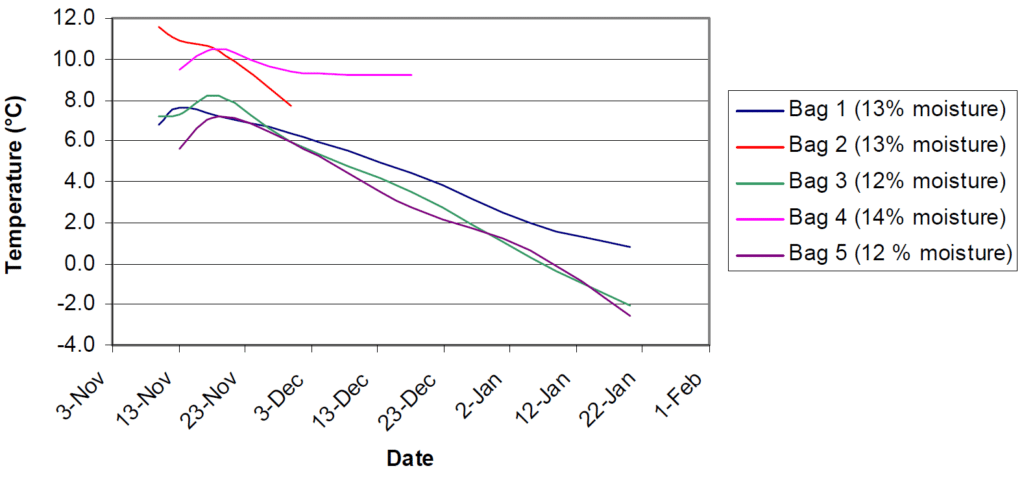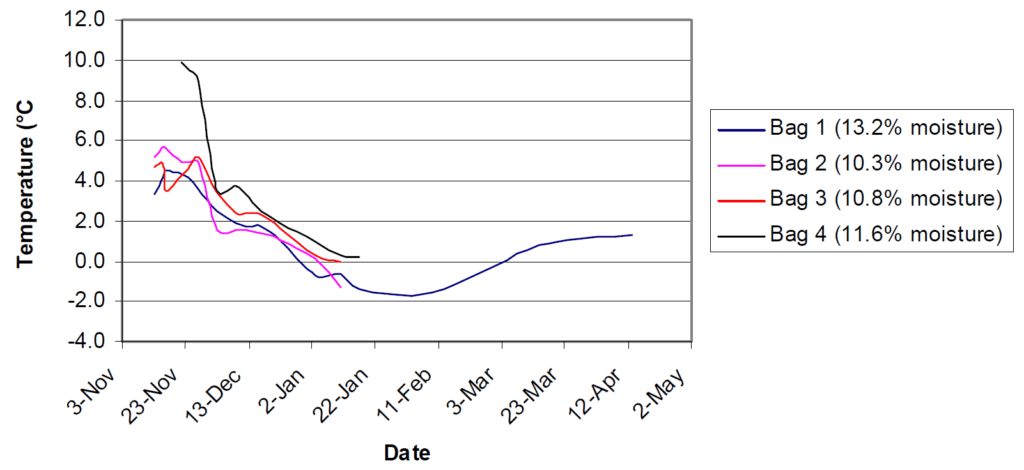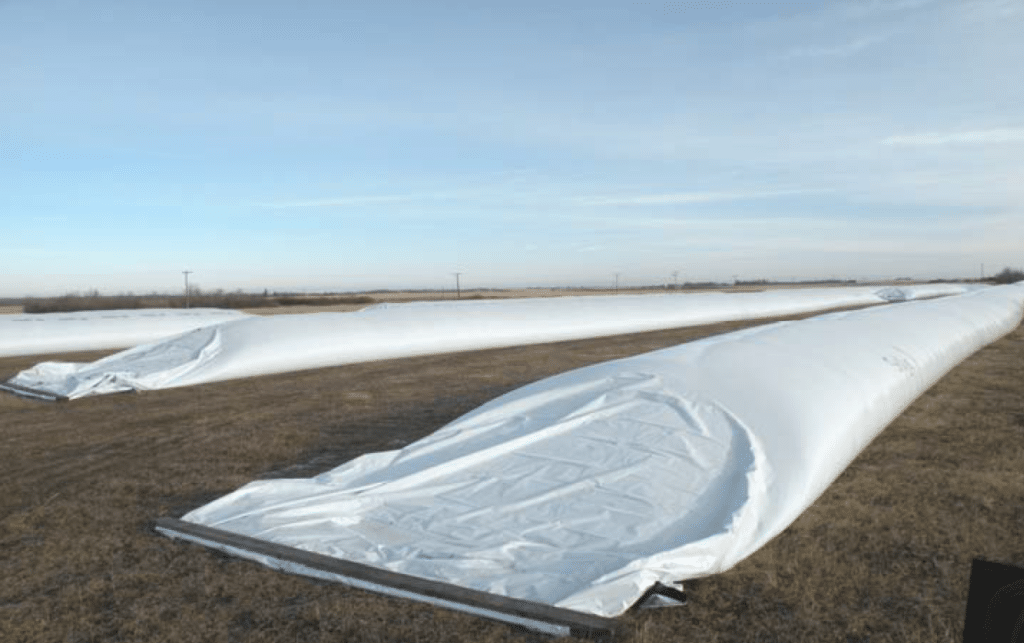Key Result
Cool air temperatures at the time of combining and storage are of tremendous value to prolonging safe storage of canola. Temperatures must be monitored at least twice per week, until temperatures stabilize or decrease to safe levels, for all storage options. For storage bags, monitoring every 25 feet may be adequate.
Project Summary
Background
Weather conditions during the 2009 cropping season were such that Saskatchewan crops were delayed in development from establishment and through to fall. Fall harvest, particularly canola, was pushed into October and eventually November. Unusually snowy, wet and cool conditions in October resulted in pressure to harvest canola at much higher than usual moisture contents during that month. When harvest finally occurred, most of the canola was between 10 – 13 per cent moisture, so storage continued to be a concern.

Some producers were tempted to use bag storage given rumors that canola would store better there than in bins. Bag storage was also viewed to have advantages due to their portable nature and providing time and labor efficiencies during a high pressure season. No known data had been published to support the perceived effectiveness of bags, so this project addressed this. To gain knowledge on the potential value of storing canola in bags, this research monitored canola storage bags in north-central Saskatchewan.
Methodology
Nineteen bags were targeted and complete information was obtained for 11 of those bags. On larger bags (12000 bu) more than one monitoring site was chosen as temperatures were thought to differ along the bag. Spots on the bag were chosen on the side but closer to the top, as there is less chance for the bag to split and less chance for canola to spill out.
The chosen area was wiped down with a rag to make sure that it was free from any moisture or dirt. Once clean, bag tape was applied to the sampling spots prior to puncturing with probe. The probes were left in the bag for 2-3 minutes usually to allow the thermocouple temperature to equilibrate, before reading the temperature, and removing the probe.

As time permitted, bags were monitored twice per week, then less often as temperatures either stabilized or cooled. Canola samples were taken at or close to time of filling and emptying, then were tested by Bunge for moisture, dockage, green seeds and damage. Maximum air temperatures were gathered from Environment Canada for the days that bags were monitored.
Results
Canola temperatures decreased relatively well, given elevated moisture contents. The air temperatures were relatively cool (2-16°C during November), which would have been helpful for maintaining or cooling the canola. Earlier in the season, when air temperatures are warmer, it may have been much more difficult to cool these bags down.
Bag 1 was monitored until spring and canola temperatures also rose with increasing air temperature.
In all cases with this project, when canola temperatures were seen to either increase or remain constant, the producer moved the canola for sale or drying, so as to avoid
spoilage. In particular, two side by side bags with 12 and 14% moisture provided an indication of the difference in behavior at the two moisture contents. The higher moisture canola did not decrease in temperature to the same degree and therefore was moved before it became a potential problem.
To get more information about how moisture conditions change within a bag, data was taken from two to eight points within any single bag. Tisdale, Prince Albert and Kinistino, for example, had data were taken at six to eight points along the bag, given different conditions at time of combining and filling the bag. In one case, the temperature at one location along the bag was as much as 7°C warmer than other sites within the same bag and the producer moved this canola shortly thereafter.

Storage Bags (Humboldt sites); Graph from the final report

Storage Bags (Prince Albert and Kinistino sites); Graph from the final report
Recommendations
This project discovered more about the use of grain storage bags and confirmed many previously known recommendations:

- All storage options require monitoring of temperatures, at least twice per week until temperatures stabilize or decrease to safe levels.
- Recording temperatures will offer some insight into the temperature trends and provide valuable information on which to base decisions for moving and drying all crops.
- When filling a bag, make notes, on the bag itself, the location, filling times, grain and air conditions. This may also guide monitoring points within the bag.
- All storage options require monitoring of several locations within the volume of grains or oilseeds, given the potential for differences in quality of grains or oilseeds within a given container. For storage bags, monitoring every 25 feet may be adequate. One might also consider monitoring conditions towards the bottom of the bag. One should not assume similar conditions among multiple bags nor for an entire single bag.
- Given the flexibility of volumes which can be contained in storage bags, there may be worthwhile advantages to separating grains or oilseeds based on qualities such as moisture content or dockage to reduce the risk of spoiling larger quantities of product in a large single container.
- Cool air temperatures at time of combining and storage are of tremendous value to prolonging safe storage of canola.
Further research
There are needs for detailed research to provide further information to compare bin and bag storage of canola as well as revisit recommendations, given the increasing oil content of new canola varieties.





